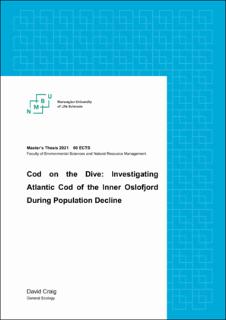| dc.description.abstract | The Atlantic Cod population of the Inner Oslofjord is in the midst of a collapse and a catch ban has been in effect since 2019. This project was designed to study demography, population size and migration in the Atlantic cod population of the inner Oslofjord, a direct comparison to a similar study in 2011-2012. This would allow me to evaluate the current state of the population and help determine whether the Inner Oslofjord cod fishing ban of 2019 has had any early impact. After nearly two years of field work, using a mark – recapture method where 19-20 fyke nets were used in three zones across the inner Oslofjord to provide randomized and stratified sampling, catches and re-catches were alarmingly low, as was the physical condition of many individuals. 39 out of a total catch of 106 individuals had a condition factor of less than 0.8. The majority of other cod individuals were close to this threshold, and most individuals were below or well below expected weight values (based on Skagerak Cod data). Catch per unit effort (CPUE) decreased by almost 70 % from 2011-2012 to 2019-2020 from 0.23 individuals/trap/day to 0.07 on average. These figures effectively ruled out a study of movement and mortality and instead led me to study the individual age and growth rate, along with total size and health of the population. The decline in both number and physical condition of cod in the inner Oslofjord is alarming. My results across three sampling zones indicate that the pollution and salinity found around the river outlets may not be limiting the growth of cod in the way we would have expected, with no clear trend seen across the gradient. Season effect and bottom type showed significant trends in catch per unit effort (CPUE). Several factors may be involved, with habitat destruction, regime shift, predation, climate change, thiamine deficiency and over-fishing all possible culprits. Further study will be essential in order to fully understand what is happening to this population, and how to protect and improve it. | en_US |

